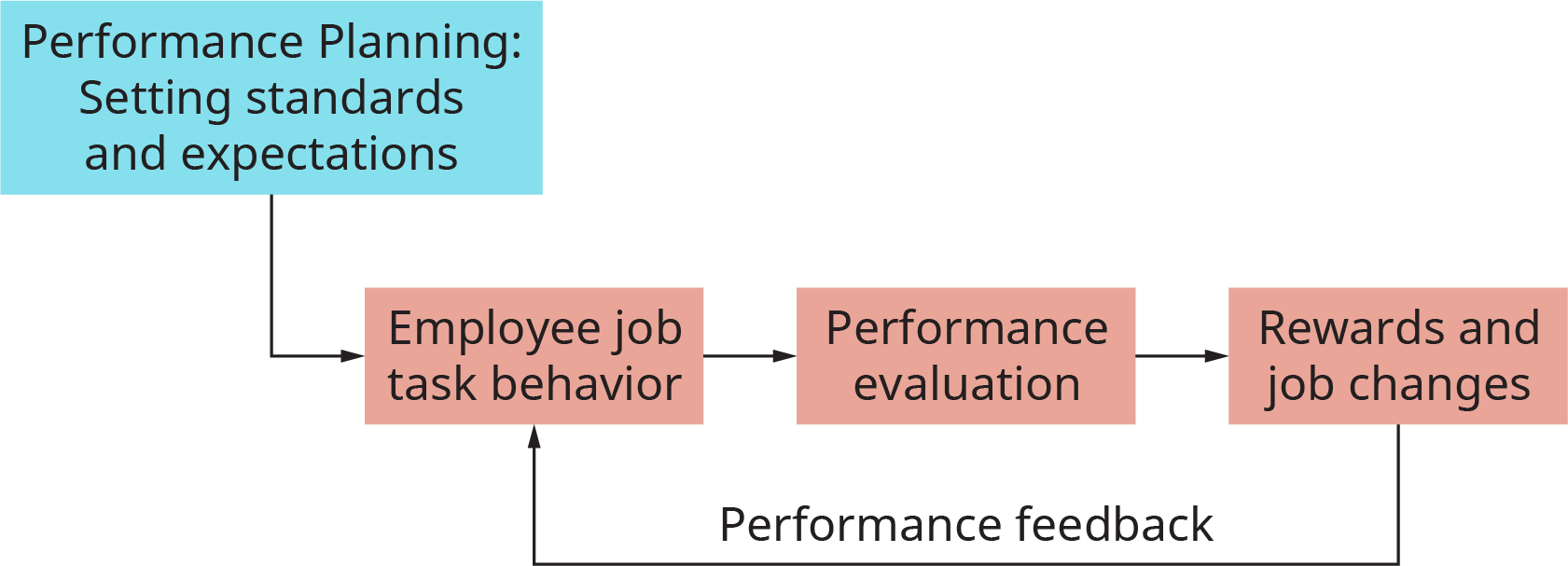Performance Appraisals
Along with employee orientation and training, new employees learn about performance expectations through performance planning and evaluation. Managers provide employees with expectations about the job. These are communicated as job objectives, schedules, deadlines, and product and/or service quality requirements. As an employee performs job tasks, the supervisor periodically evaluates the employee’s efforts. A performance appraisal is a comparison of actual performance with expected performance to determine an employee’s contributions to the organization and to make decisions about training, compensation, promotion, and other job changes.
Developing an Appropriate Appraisal Process
The performance planning and appraisal process is shown and described below.

- The manager establishes performance standards.
- The employee works to meet the standards and expectations.
- The employee’s supervisor evaluates the employee’s work in terms of quality and quantity of output and various characteristics such as job knowledge, initiative, relationships with others, and attendance and punctuality.
- Following the performance evaluation, reward (pay raise) and job change (promotion) decisions can be made. If work is unsatisfactory, the employee may be put on a performance improvement plan, which outlines the behaviors or performance that must be improved, the milestones and time periods to improve performance, and what will occur if performance is not improved.
- Rewards are positive feedback and provide reinforcement, or encouragement, for the employee to continue improving their performance.
It was once common practice for performance appraisals to be conducted on an annual basis, but most companies have moved away from that standard. Instead, managers are encouraged to provide employees with continuous real-time feedback so that skill development and job performance can be improved more rapidly.
One significant problem in creating an appraisal process is that no single performance appraisal method will be perfect for every organization.[1] Establishing an appropriate process involves significant planning and analysis in order to provide quality feedback to the employee.
SMART Test
Peter Drucker developed a method called Management by Objectives (MBO) and suggested that employees be evaluated by the SMART test:
- Specific
- Measurable
- Achievable
- Realistic
- Time-related
The process of an evaluation typically includes one or more of the following:
- An assessment of how well the employee is doing. Sometimes this includes a scale rating indicating strengths and weaknesses in key areas (e.g., ability to follow instructions, complete work on time, and work with others effectively). It’s also common for the supervisor and manager to discuss and determine the key areas.
- Employee goals with a deadline. Sometimes the employee may voluntarily offer a goal, while at other times it will be set by his or her boss. A significantly underperforming employee may be given a performance improvement plan, which details specific goals that must be met to keep the job.
- Feedback from coworkers and supervisors. The employee may also have the chance to share feelings, concerns, and suggestions about the workplace.
- Details about workplace standing, promotions, and pay raises. Sometimes an employee who has performed very well since the last review period may get an increase in pay or be promoted to a more prestigious position.
Methods of Performance Appraisal
Numerous methods exist for gauging an employee’s performance, and each has strengths and weaknesses depending on the environment. The following outlines some of the more commonly used methods, as well as some recently developed ones that can be useful for various feedback situations:
- Graphic rating scales: This method involves assigning some form of rating system to pertinent traits. Ratings can be numerical ranges (1–5), descriptive categories (below average, average, above average), or scales between desirable and undesirable traits (poor ↔ excellent). This method can be simple to set up and easy to follow but is often criticized for being too subjective, leaving the evaluator to define broad traits such “leadership ability” or “conformance with standards.”[3]
- Behavioral methods: A broad category encompassing several methods with similar attributes. These methods identify to what extent an employee displays certain behaviors, such as asking a customer to identify the usefulness of a sales representative’s recommendation. While extremely useful for jobs where behavior is critical to success, identifying behaviors and standards for employees can often be very time-consuming for an organization.[4]
- 2+2: The 2+2 feedback system demonstrates how appraisals can be used primarily for improvement purposes. By offering employees two compliments and two suggestions for improvement focused around high-priority areas, creators Douglas and Dwight Allen suggest that organizations can become “more pleasant, more dynamic, and more productive.”[5] If the goal is employee improvement, this system can provide significant benefits; however, if the goals are compensation changes and rankings, the system provides little benefit.
Appraisal methodologies depend greatly on the type of work being done; an assembly worker will require a very different appraisal system from a business consultant. Significant planning will be required to develop appropriate methods for each business unit in an organization in order to obtain maximum performance towards the appraisal goals.